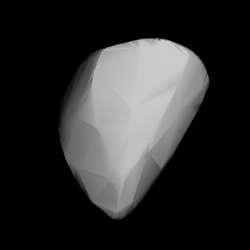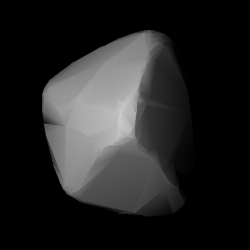Related Research Articles
862 Franzia is a stony background asteroid from the central regions of the asteroid belt. It was discovered by German astronomer Max Wolf at the Heidelberg-Königstuhl State Observatory on 28 January 1917. The common S-type asteroid has a rotation period of 7.5 hours and measures approximately 28 kilometers in diameter. It was named after the discoverer's son, Franz Wolf.
910 Anneliese is a dark background asteroid, approximately 48 kilometers in diameter, located in the outer regions of the asteroid belt. It was discovered on 1 March 1919, by astronomer Karl Reinmuth at the Heidelberg-Königstuhl State Observatory in southwest Germany. The carbonaceous C-type asteroid (Ch) has a rotation period of 11.3 hours and is likely spherical in shape. It was named by German astronomer Julius Dick after his friend "Anneliese".
927 Ratisbona is a large and dark background asteroid, approximately 76 kilometers in diameter, located in the outer region of the asteroid belt. It was discovered on 16 February 1920, by astronomer Max Wolf at the Heidelberg Observatory in southwest Germany. The carbonaceous C-type asteroid (CB) has a rotation period of 12.99 hours and is rather spherical in shape. It was named after the Bavarian city of Regensburg.
978 Aidamina, provisional designation 1922 LY, is a dark background asteroid from the outer region of the asteroid belt, approximately 79 kilometers in diameter. It was discovered by astronomer Sergey Belyavsky in 1922, and later named after Aida Minaevna, a friend of the discoverer's family.
989 Schwassmannia is a stony background asteroid and a slow rotator from the central regions of the asteroid belt, approximately 12.5 kilometers in diameter. It was discovered on 18 November 1922, by astronomer Friedrich Karl Arnold Schwassmann at the Bergedorf Observatory in Hamburg, Germany. The bright S/T-type asteroid has a long rotation period of 107.9 hours. It was named after the discoverer himself.
1019 Strackea, provisional designation 1924 QN, is a stony Hungaria asteroid of the inner asteroid belt, approximately 8 kilometers in diameter. It was discovered on 3 March 1924, by astronomer Karl Reinmuth at Heidelberg Observatory in southwest Germany. It is named for German astronomer Gustav Stracke.

1022 Olympiada, provisional designation 1924 RT, is a background asteroid from the central regions of the asteroid belt, approximately 30 kilometers in diameter. It was discovered at the Simeiz Observatory on the Crimean peninsula on 23 June 1924, by Soviet astronomer Vladimir Albitsky, who named it after his mother, Olimpiada Albitskaya. The X-type asteroid has a short rotation period of 3.83 hours.

1042 Amazone, provisional designation 1925 HA, is a dark asteroid and slow rotator in the outer asteroid belt, approximately 70 kilometers in diameter. It was discovered on 22 April 1925, by German astronomer Karl Reinmuth at Heidelberg Observatory in southern Germany. It is named after the Amazons from Greek mythology.
1044 Teutonia, provisional designation 1924 RO, is a stony asteroid from the central regions of the asteroid belt, approximately 16 kilometers in diameter. It was discovered on 10 May 1924, by astronomer Karl Reinmuth at Heidelberg Observatory in southwest Germany. The asteroid was named after the land inhabited by the Teutonic people.

1116 Catriona is a carbonaceous asteroid from the outer regions of the asteroid belt, approximately 39 kilometers in diameter. It was discovered on 5 April 1929, by South African astronomer Cyril Jackson at the Union Observatory in Johannesburg. The asteroid was probably named after the 1893-novel Catriona by Robert Louis Stevenson.
1084 Tamariwa, provisional designation 1926 CC, is a carbonaceous background asteroid approximately 27 kilometres in diameter from the central regions of the asteroid belt. It was discovered on 12 February 1926, by Soviet astronomer Sergey Belyavsky at the Simeiz Observatory on the Crimean peninsula. The asteroid was named after female paratrooper Tamara Ivanova, who died at an early age.
1166 Sakuntala, provisional designation 1930 MA, is a stony background asteroid from the central regions of the asteroid belt, approximately 26 kilometers in diameter. Discovered by Praskovjya Parchomenko at Simeiz Observatory in 1930, the asteroid was named after the figure of Shakuntala from an ancient Indian drama.
1194 Aletta, provisional designation 1931 JG, is a carbonaceous asteroid from the outer region of the asteroid belt, approximately 55 kilometers in diameter. It was discovered on 13 May 1931, by South African astronomer Cyril Jackson at Johannesburg Observatory in South Africa. It was later named after the discoverer's wife Aletta Jackson.
1177 Gonnessia, provisional designation 1930 WA, is a dark background asteroid from the outer regions of the asteroid belt, approximately 99 kilometers in diameter. It was discovered on 24 November 1930, by French astronomer Louis Boyer at the Algiers Observatory in Algeria, North Africa, and named after astronomer François Gonnessiat.
1176 Lucidor, provisional designation 1930 VE, is a carbonaceous background asteroid from the central region of the asteroid belt, approximately 30 kilometers in diameter. It was discovered by Eugène Delporte in 1930, who named it after a friend.
1796 Riga, provisional designation 1966 KB, is a dark asteroid from the outer region of the asteroid belt, approximately 70 kilometers in diameter. It was discovered on 16 May 1966, by Russian astronomer Nikolai Chernykh at the Crimean Astrophysical Observatory in Nauchnyj, on the Crimean peninsula. It is named after the Latvian capital Riga.
1269 Rollandia, provisional designation 1930 SH, is a dark Hildian asteroid from the outermost region of the asteroid belt, approximately 105 kilometers (65 mi) in diameter. It was discovered on 20 September 1930, by Soviet astronomer Grigory Neujmin at the Simeiz Observatory on the Crimean peninsula. The asteroid was named after French writer Romain Rolland. The D-type asteroid has a rotation period of 17.4 hours. It was one of the last 100-kilometer sized asteroids discovered in the main belt.
1266 Tone is a dark background asteroid from the outer regions of the asteroid belt, approximately 80 kilometers in diameter. Discovered by astronomer Okuro Oikawa at the Tokyo Observatory in 1927, it was assigned the provisional designation 1927 BD. The asteroid was later named after the Tone River, one of Japan's largest rivers.

2120 Tyumenia is a dark background asteroid, approximately 45 kilometers in diameter, located in the outer regions of the asteroid belt. It was discovered on 9 September 1967, by Soviet astronomer Tamara Smirnova at the Crimean Astrophysical Observatory in Nauchnyj, on the Crimean peninsula. The asteroid was named for the now Russian district of Tyumen Oblast in Western Siberia.
1708 Pólit, provisional designation 1929 XA, is a very dark asteroid from the outer region of the asteroid belt, approximately 29 kilometers in diameter. It was discovered on 30 November 1929, by Spanish astronomer of Catalan origin Josep Comas i Solà at the Fabra Observatory in Barcelona, and was later named after Catalan astronomer Isidre Pòlit i Boixareu.
References
- 1 2 3 4 "JPL Small-Body Database Browser: 3915 Fukushima (1988 PA1)" (2017-05-01 last obs.). Jet Propulsion Laboratory . Retrieved 4 July 2017.
- 1 2 3 Schmadel, Lutz D. (2007). "(3915) Fukushima". Dictionary of Minor Planet Names – (3915) Fukushima. Springer Berlin Heidelberg. p. 333. doi:10.1007/978-3-540-29925-7_3904. ISBN 978-3-540-00238-3.
- 1 2 3 4 5 "LCDB Data for (3915) Fukushima". Asteroid Lightcurve Database (LCDB). Retrieved 5 June 2016.
- 1 2 3 4 Tedesco, E. F.; Noah, P. V.; Noah, M.; Price, S. D. (October 2004). "IRAS Minor Planet Survey V6.0". NASA Planetary Data System. 12: IRAS-A-FPA-3-RDR-IMPS-V6.0. Bibcode:2004PDSS...12.....T . Retrieved 22 October 2019.
- 1 2 3 Masiero, Joseph R.; Grav, T.; Mainzer, A. K.; Nugent, C. R.; Bauer, J. M.; Stevenson, R.; et al. (August 2014). "Main-belt Asteroids with WISE/NEOWISE: Near-infrared Albedos". The Astrophysical Journal. 791 (2): 11. arXiv: 1406.6645 . Bibcode:2014ApJ...791..121M. doi:10.1088/0004-637X/791/2/121 . Retrieved 5 December 2016.
- 1 2 3 4 5 6 Mainzer, A.; Grav, T.; Masiero, J.; Hand, E.; Bauer, J.; Tholen, D.; et al. (November 2011). "NEOWISE Studies of Spectrophotometrically Classified Asteroids: Preliminary Results". The Astrophysical Journal. 741 (2): 25. arXiv: 1109.6407 . Bibcode:2011ApJ...741...90M. doi:10.1088/0004-637X/741/2/90 . Retrieved 5 June 2016.
- 1 2 3 4 Usui, Fumihiko; Kuroda, Daisuke; Müller, Thomas G.; Hasegawa, Sunao; Ishiguro, Masateru; Ootsubo, Takafumi; et al. (October 2011). "Asteroid Catalog Using Akari: AKARI/IRC Mid-Infrared Asteroid Survey". Publications of the Astronomical Society of Japan. 63 (5): 1117–1138. Bibcode:2011PASJ...63.1117U. doi: 10.1093/pasj/63.5.1117 . (online, AcuA catalog p. 153)
- 1 2 Warner, Brian D. (March 2004). "Rotation rates for asteroids 875, 926, 1679, 1796, 3915, 4209, and 34817". The Minor Planet Bulletin. 31 (1): 19–22. Bibcode:2004MPBu...31...19W. ISSN 1052-8091 . Retrieved 1 February 2016.
- 1 2 Shipley, Heath; Dillard, Alex; Kendall, Jordan; Reichert, Matthew; Sauppe, Jason; Shaffer, Nelson; et al. (September 2008). "Asteroid Lightcurve Analysis at the Oakley Observatory - September 2007". The Minor Planet Bulletin. 35 (3): 99–102. Bibcode:2008MPBu...35...99S. ISSN 1052-8091 . Retrieved 1 February 2016.
- 1 2 Behrend, Raoul. "Asteroids and comets rotation curves – (3915) Fukushima". Geneva Observatory . Retrieved 5 June 2016.
- 1 2 Warner, Brian D. (April 2011). "Upon Further Review: VI. An Examination of Previous Lightcurve Analysis from the Palmer Divide Observatory". The Minor Planet Bulletin. 38 (2): 96–101. Bibcode:2011MPBu...38...96W. ISSN 1052-8091 . Retrieved 1 February 2016.
- 1 2 "3915 Fukushima (1988 PA1)". Minor Planet Center. Retrieved 5 June 2016.
- ↑ Asteroid Occultation Updates
- ↑ "MPC/MPO/MPS Archive". Minor Planet Center. Retrieved 5 June 2016.